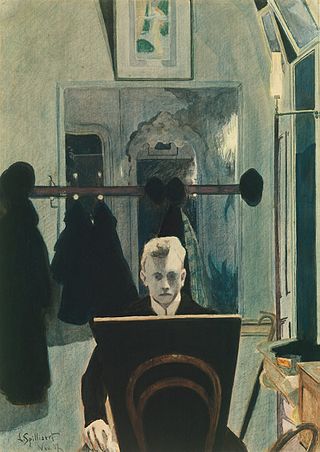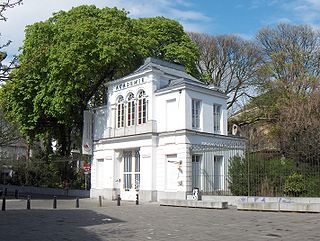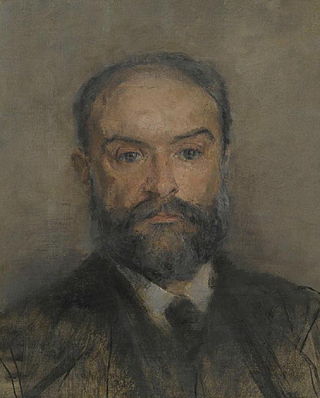
Philip Fruytiers (1610–1666) was a Flemish Baroque painter and engraver. Until the 1960s, he was especially known for his miniature portraits in watercolor and gouache. Since then, several large canvases signed with the monogram PHF have been ascribed to him. These new findings have led to a renewed appreciation for his contribution to the Antwerp Baroque.

Léon Spilliaert was a Belgian symbolist painter and graphic artist.

The Royal Museums of Fine Arts of Belgium are a group of art museums in Brussels, Belgium. They include six museums: the Oldmasters Museum, the Magritte Museum, the Fin-de-Siècle Museum, the Modern Museum, the Antoine Wiertz Museum and the Constantin Meunier Museum.

The Royal Academy of Fine Arts Antwerp is an art academy located in Antwerp, Belgium. It is one of the oldest of its kind in Europe. It was founded in 1663 by David Teniers the Younger, painter to the Archduke Leopold Wilhelm and Don Juan of Austria. Teniers was master of the Guild of St Luke—which embraced arts and some handicrafts—and petitioned Philip IV of Spain, then master of the Spanish Netherlands, to grant a royal charter to establish a Fine Arts Academy in Antwerp. It houses the Antwerp Fashion Academy.
Museum voor Schone Kunsten may refer to:

Périclès Pantazis was a major Greek impressionist painter of the 19th century who gained a great reputation as an artist initially in Belgium.

The Royal Flemish Academy of Belgium for Science and the Arts is one of an independent learned society of science and arts of the Flemish Community in Belgium. It is one of Belgium's numerous academies and traces its origin to 1772 when the Imperial and Royal Academy of Brussels was founded by empress Maria Theresia.
The Royal Academy of Science, Letters and Fine Arts of Belgium is the independent learned society of science and arts of the French Community of Belgium. One of Belgium's numerous academies, it is the French-speaking counterpart of the Royal Flemish Academy of Belgium for Science and the Arts. In 2001 both academies founded a joint association for the purpose of promoting science and arts on an international level: The Royal Academies for Science and the Arts of Belgium (RASAB). All three institutions are located in the same building, the Academy Palace in Brussels.

Modest Huys was a Flemish impressionist and luminist painter, who is regarded as one of the greatest Belgian painters of the 20th century.

Henri, Hendrik, or Henry Voordecker was a Belgian painter of genre scenes, especially of birds such as pigeons – his most notable works include Hunter's Home. By late in his career he was regarded as perhaps the most distinguished painter in Brussels, and was also successful in Britain.
Lucien Hoffman was a Belgian sculptor, pupil of Victor Rousseau.

Égide Rombaux was a Belgian symbolist sculptor.

Bart Cassiman, freelance-curator, art critic and editor, is an art historian and studied press- and communication sciences at the Ghent University (1979-1984).

Godefroid Devreese was a Belgian sculptor. His work was part of the sculpture event in the art competition at the 1936 Summer Olympics.

The Parisian Sphinx is an oil on canvas painting by Belgian painter Alfred Stevens. Painted between 1875 and 1877, it depicts a dreamy young woman gently supporting her head with her hand. The painting is part of the permanent collection of the Royal Museum of Fine Arts in Antwerp. The Parisian Sphinx shows the influence of Vermeer and the other Netherlandish old masters on Stevens, and testifies to the Symbolist influence in the latter's day. It incorporates a harmonious juxtaposition of superficial Dutch realism with the spreading Symbolist manner, as opposed to the bottom-up, pluralistic symbolism of the declining Romanticism. While well executed and apparently quite realistic, the painting has also a non-plain meaning.

Portrait of Stephan Geraedts, Husband of Isabella Coymans is an oil on canvas painting by Dutch Golden Age painter Frans Hals. The painting was originally part of a couple of pendant wedding portraits. Hals probably painted the present portrait, Stephanus Geraerdts', alderman in Haarlem, and the accompanying portrait of the latter's wife Isabella Coymans around 1650–1652, six or seven years after their marriage in 1644. Isabella's portrait is now in a private collection in Paris.

Self-Portrait is an oil-on-canvas painting by the French Neoclassical artist Jean-Auguste-Dominique Ingres. The painting measures 25.2 x 20.9 inches and is part of the permanent collection of the Royal Museum of Fine Arts in Antwerp. This painting is one of the last portraits by Ingres.

Alexis Van Hamme was a Belgian painter; known primarily for historical genre scenes.

Marthe Guillain (1890-1974) was a Belgian painter.

The Castle of Temse also known as 'the (old) castle', 'Arcques', 'Hercken' or 'Herkenstein', was a castle/moated castle that was located on the left bank of the Scheldt in Temse. It existed before the 12th century and was demolished in 1782. More to the north of the old castle, a new castle was built from 1783 to 1787 in classicist style, which in turn was demolished in 1965 to make way for the swimming pool of Temse. There are no remnants of the old castle, except for the current Scheldt Park, which belonged to the domain of the old and new castle. A model of the old castle can be seen in the municipal museum of Temse.

















